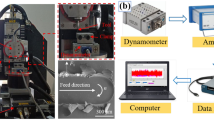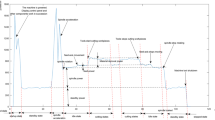Abstract
The energy efficiency and volume-energy ratio of milling cutter are important index to evaluate energy utilization rate of milling cutter. The milling process is not only affected by random factors such as cutter tooth error but also by non-steady-state factors such as milling vibration and cutter tooth wear. These factors lead to the uncertainty of machining process, and it is difficult to identify energy transfer relationship of milling cutter. According to finite element simulation analysis results of milling cutter, the wear depth of cutting edge was obtained. The coordinates of selected point on cutting edge were solved, and the time varying of cutting edge equation after wear was revealed. According to the calculation method of instantaneous shear energy efficiency, volume shear energy ratio, and volume tangent-force energy ratio, the variation of energy efficiency and volume-energy ratio along the cutting edge was obtained. And temporal-spatial distribution of energy efficiency and volume-energy ratio under multiple factors was revealed. The influencing mechanism of energy efficiency and volume-energy ratio of cutter teeth was identified. A calculation method for distribution of energy efficiency and volume-energy ratio under multiple factors was proposed. The validity of the model was verified by using energy efficiency and volume-energy ratio under different cutting parameters. The results showed that above models could distinguish the influence of unsteady factors on energy efficiency and volume-energy ratio, which could provide a basic model for high-energy-efficiency design of cutter teeth.





























Similar content being viewed by others
Abbreviations
- P(t):
-
Input energy
- P ie(t):
-
Energy in the milling cutter body
- P ce(t):
-
Centrifugal energy for milling cutter
- P c(t):
-
Tangential force energy
- P c v(t):
-
Vibration energy for milling cutter
- P s i(t):
-
Shear force energy
- P f i(t):
-
Friction energy
- P sv i(t):
-
Energy consumption for material removal
- P fw i(t):
-
Wear energy for tooth flank
- Q w(t):
-
Wear on the rake face
- f w(t):
-
Wear on the cutting edge of cutter tooth
- H w(t):
-
Wear on tool flank of cutter tooth
- SEE:
-
Shear energy efficiency
- VER:
-
Volume-energy ratio
- VSER:
-
Volume shear energy ratio
- VTER:
-
Volume tangent-force energy ratio
References
Jamil M, Zhao W, He N, Gupta MK, Sarikaya M, Khan AM, Sanjay MR, Siengchin S, Pimenov DY (2021) Sustainable milling of Ti–6Al–4V: a trade-off between energy efficiency, carbon emissions and machining characteristics under MQL and cryogenic environment. J Clean Prod 281:125374. https://doi.org/10.1016/j.jclepro.2020.125374
Oh NS, Woo WS, Lee CM (2018) A study on the machining characteristics and energy efficiency of Ti-6Al-4V in laser-assisted trochoidal milling. Int J Precis Eng Manuf Green Tech 5:37–45. https://doi.org/10.1007/s40684-018-0004-y
Płodzień M, Żyłka Ł, Sułkowicz P, Zak K, Wojciechowski S (2021) High-performance face milling of 42CrMo4 steel: influence of entering angle on the measured surface roughness, cutting force and vibration amplitude. Mater 14(9):2196. https://doi.org/10.3390/ma14092196
Li C, Duan CZ, Chang BB (2022) Instantaneous cutting force model considering the material structural characteristics and dynamic variations in the entry and exit angles during end milling of the aluminum honeycomb core. Mech Syst Signal Proce 181:109456. https://doi.org/10.1016/j.ymssp.2022.109456
Zhang YB, Bai QS, Zhang FR, Wang P (2022) Calculation and analysis of quasi-dynamic cutting force and volume-energy ratio in micro-milling Ti6Al4V. Int J Adv Manuf Technol 120(9):6067–6078. https://doi.org/10.1007/S00170-022-09086-3
Lei ZZ, Lin XJ, Wu G, Sun LZ (2021) Cutting force modeling and experimental study for ball-end milling of free-form surfaces. J Math Probl Eng 2021:3344889. https://doi.org/10.1155/2021/3344889
Shi KN, Liu N, Liu CL, Ren JX, Yang SS, Tan WC (2022) Indirect approach for predicting cutting force coefficients and power consumption in milling process. Adv Manuf 10(1):101–103. https://doi.org/10.1007/S40436-021-00370-1
Tesic S, Cica D, Borojevic S, Sredanovic B, Zeljkovic M, Kramar D, Pusavec F (2022) Optimization and prediction of specific energy consumption in ball-end milling of Ti-6Al-4V alloy under MQL and cryogenic cooling/lubrication conditions. Int J Precis Eng Manuf Green Tech 9(6):1427–1437. https://doi.org/10.1007/S40684-021-00413-9
Sun ZW, Wang SJ, To SJ, Guo GY (2023) Modelling and analysis of the volume-energy ratio for ultra-precision diamond cutting of Ti6Al4V alloy. J Manuf Process 85:844–857. https://doi.org/10.1016/j.jmapro.2022.12.021
Asrai RI, New The root mean square man ST, NaVSERhi A (2018) A mechanistic model of energy consumption in milling. Int J Prod Res 56(1–2):642–659. https://doi.org/10.1080/00207543.2017.1404160
Hu ZH, Qin CJ, Shi ZW, Tang YR, Zhang XD, Zou YM (2020) An effective thread milling force prediction model considering instantaneous cutting thickness based on the cylindrical thread milling simplified to side milling process. Int J Adv Manuf Technol 110(5–6):1275–1283. https://doi.org/10.1007/s00170-020-05919-1
Shi KN, Ren JX, Wang SB, Liu N, Liu ZM, Zhang DH, Lu WF (2019) An improved cutting power-based model for evaluating total energy consumption in general end milling process. J Clean Prod 231:1330–1341. https://doi.org/10.1016/j.jclepro.2019.05.323
Lu FY, Zhou GH, Liu Y, Zhang C (2022) Ensemble transfer learning for cutting energy consumption prediction of aviation parts towards green manufacturing. J Clean Prod 331:129920. https://doi.org/10.1016/j.jclepro.2021.129920
Xu LH, Huang CZ, Li CW, Wang J, Liu HL, Wang XD (2020) A novel intelligent reasoning system to estimate energy consumption and optimize cutting parameters toward sustainable machining. J Clean Prod 261:121160. https://doi.org/10.1016/j.jclepro.2020.121160
Shin SJ, Woo JY, Rachuri S (2017) Energy efficiency of milling machining: component modeling and online optimization of cutting parameters. J Clean Prod 161:12–29. https://doi.org/10.1016/j.jclepro.2017.05.013
Zhang T, Liu ZQ, Sun XD, Dong LL, Zhu GL (2020) Investigation on specific milling energy and energy efficiency in high-speed milling based on energy flow theory. Energy 192:116596. https://doi.org/10.1016/j.energy.2019.116596
Han FJ, Li L, Cai W, Li CB, Deng XG, JohnW S (2020) Parameters optimization considering the trade-off between cutting power and MRR based on linear decreasing particle swarm algorithm in milling. J Clean Prod 2020(262):121388–121388. https://doi.org/10.1016/j.jclepro.2020.121388
Li CX, Zhao GY, Zhao YG, Xu S, Zheng ZF (2021) Prediction model of net cutting specific energy based on energy flow in milling. Int J Precis Eng Manuf Green Tech 9(5):1285–1303. https://doi.org/10.1007/S40684-021-00397-6
Mazizur R, Mustafizur R, Mia M, Gupta MK, Sen B, Ahmed A (2020) Investigation of the volume-energy ratio and its effect in shearing dominant precision micro cutting. J Mater Process Technol 283:116688. https://doi.org/10.1016/j.jmatprotec.2020.116688
Deng ZH, Zhang H, Fu YH, Wan LL, Liu W (2017) Optimization of process parameters for minimum energy consumption based on cutting specific energy consumption. J Clean Prod 166:1407–1414. https://doi.org/10.1016/j.jclepro.2017.08.022
Lee RN, Hussain SJ, Menq CH, Wang JJ (2020) Optimal insert edge geometry for minimum volume-energy ratio in face milling. J Chin Soc Mech Eng Ser C: Transactions of the Chinese Society of Mechanical Engineers 41:725–733
Yao Y, Zhu HT, Huang CZ, Wang J, Zhang P, Yao P (2019) On the relations between the volume-energy ratio and surface generation in micro-milling of maraging steel. Int J Adv Manuf Technol 104(1–4):585–598. https://doi.org/10.1007/s00170-019-03911-y
Mntyl A, Hintikka J, Frondelius T, Vaara J, Lehtovaara A, Juoksukangas J (2020) Prediction of contact condition and surface damage by simulating variable friction coefficient and wear. Tribol Int 143:106054. https://doi.org/10.1016/j.triboint.2019.106054
Kitamura T, Tanaka R, Yamane Y, Sekiya K, Yamada K (2020) Evaluation method for friction coefficient of machining fluids using cutting force in micro feed end milling. Appl Mech Mater 62:232–243. https://doi.org/10.1016/j.precisioneng.2019.12.007
Funding
This research was supported by the Heilongjiang Provincial Natural Science Foundation of China [grant number ZD2020E008]; and the National Natural Science Foundation of China [grant numbers 52105440, 51875145].
Author information
Authors and Affiliations
Contributions
Conceptualization, BJ and LF; methodology, BJ and LF; software, LF and BW; validation, LF; investigation, LF and BW; data curation, LF; writing—original draft preparation, LF; writing—review and editing, LF and PZ; supervision, BJ and PZ; project administration, BJ and PZ; funding acquisition, BJ and PZ. All authors have read and agreed to the published version of the manuscript.
Corresponding author
Ethics declarations
Ethics approval and consent to participate
This chapter does not contain any studies with human participants or animals performed by any of the authors.
Consent for publication
All authors consent to the publications of the manuscript in this journal.
Conflict of interest
The authors declare no competing interests.
Additional information
Publisher's Note
Springer Nature remains neutral with regard to jurisdictional claims in published maps and institutional affiliations.
Rights and permissions
Springer Nature or its licensor (e.g. a society or other partner) holds exclusive rights to this article under a publishing agreement with the author(s) or other rightsholder(s); author self-archiving of the accepted manuscript version of this article is solely governed by the terms of such publishing agreement and applicable law.
About this article
Cite this article
Fan, L., Jiang, B., Zhao, P. et al. Calculation method for instantaneous shear energy efficiency and volume-energy ratio of milling cutter under multiple factors. Int J Adv Manuf Technol 129, 2897–2920 (2023). https://doi.org/10.1007/s00170-023-12449-z
Received:
Accepted:
Published:
Issue Date:
DOI: https://doi.org/10.1007/s00170-023-12449-z




